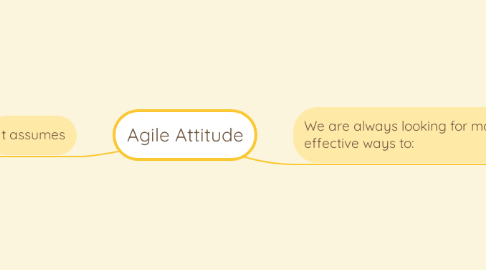
1. It assumes
1.1. The best solution is typically unknowable upfront and only discoverable through test and learn cycles
1.1.1. People will tell you what they want when you have given them what they asked for
1.2. A minimally viable solution (i.e., one that minimally meets the constraints) may not even be possible within the current constraints, so the sooner we find that out, the sooner we can change it or move to another piece of work, the better
1.2.1. There are often risks that if not addressed/discovered could cause the initiative to fail, so better expose them asap
1.3. We may need to stop and change focus at any time due to a different higher priority piece of work, so we will at least have something to deliver to show for our efforts even if it is only a minimal solution
1.4. Workers are trusted and given a safe environment to experiment
1.5. Planning is very important, but plans are going to be wrong so we better learn to adapt them rapidly
1.6. Authority to make decisions is aligned to peoples responsibilities
1.7. Authority is given where information, competence and clarity lie (i.e., it's as decentralised as it needs to be)
1.8. It's difficult to assess the value of a feature over time; this risk needs to be actively mitigated during the features lifetime (not just set once at the beginning)
1.9. Not all features are equal and they should be perceived as a liability unless proven otherwise!
1.10. There is always something to improve -- we will never reach a state of perfection and that's just fine!
1.11. Knowledge work is perishable: the tacit nature of knowledge is difficult to transfer and it's value diminishes over time
2. We are always looking for more effective ways to:
2.1. 1. manage uncertainty (VUCA)
2.1.1. we frequently inspect and adapt our plan, priorities and way of working/approach
2.1.1.1. we seek to understand the opportunity cost of continuing work versus working on something else
2.1.2. we make small changes and seek feedback often
2.1.2.1. we deliver early and often
2.1.2.2. we seek to respond faster with improved predictability and improved lead times
2.1.2.3. we build quality into our work from the very beginning and address issues as soon as they arise
2.1.2.3.1. we seek to catch problems when they are still small
2.1.2.4. we treat work in progress as if it's a liability rather than an asset
2.1.2.4.1. we limit our WIP
2.1.3. we use the following process:
2.1.3.1. we determine feasibility, then viability, then we deliver the highest value until opportunity cost informs us to change focus
2.1.4. we validate the crucial assumptions as early and quickly as possible (game breaking risk)
2.1.4.1. unvalidated (impactful) assumptions
2.1.5. we learn through iteration, experimentation and by doing
2.1.5.1. small, measurable, reversible and safe (limited blast radius) experiments
2.1.5.2. we make progress with imperfect information rather than get stuck in analysis paralysis
2.2. 2. seek win-wins and develop happy stakeholders
2.2.1. we seek to solve the right problem
2.2.1.1. customer focus
2.2.1.1.1. we seek to understand our customer’s journey, pains and gains
2.2.1.2. customer proximity
2.2.1.3. we seek to understand root causes
2.2.2. we cocreate solutions
2.2.2.1. we foster a high trust culture
2.2.2.2. we practice unconstrained thinking
2.2.3. we maximise the amount of work not done
2.2.3.1. simplest possible thing that will work
2.2.3.2. YAGNI
2.2.3.3. walking skeleton
2.2.4. we celebrate our successes and our learnings from failures
2.2.5. we redefine 'scope' in terms of outcomes (rather than outputs)
2.2.6. we seek to make the best use of now by understanding and focusing on the most important thing
2.2.7. we work at a sustainable pace
2.3. 3. visualise our work: progress, setbacks, unvalidated decisions and communicate clearly our mission and direction
2.3.1. form a big picture, end-to-end, prioritised and long view of delivery
2.4. 4. automate repeatable tasks
2.4.1. computers do repetitive tasks, people solve problems
2.5. 5. make fact-based decisions
2.5.1. actionable metrics to support decision making
2.6. 6. embrace a craft ethic around technical excellence and pursue high quality through pride of workmanship
2.7. 7. minimise bureaucracy and waste (in the Lean sense)
2.8. 8. work with small, close, passionate, empowered, trusted, self-organising, dedicated, long-lived, cross-functional teams
2.8.1. the team is set up to succeed and supported throughout
2.8.2. the environment is made safe to be curious, experiment and fail
2.8.3. the team builds in resilience
2.8.3.1. redundancy of skills and knowledge
2.8.4. team members share ownership of mission, depend on each other, set high expectations and hold each other accountable
2.8.5. team members swarm on problems
2.9. 9. encourage and reward people who
2.9.1. care and collaborate deeply
2.9.1.1. ask for help
2.9.1.2. seek to help
2.9.2. are willing to take small steps and seek feedback
2.9.2.1. incremental and iterative delivery
2.9.3. are adaptable
2.9.4. willing to work outside their expertise
